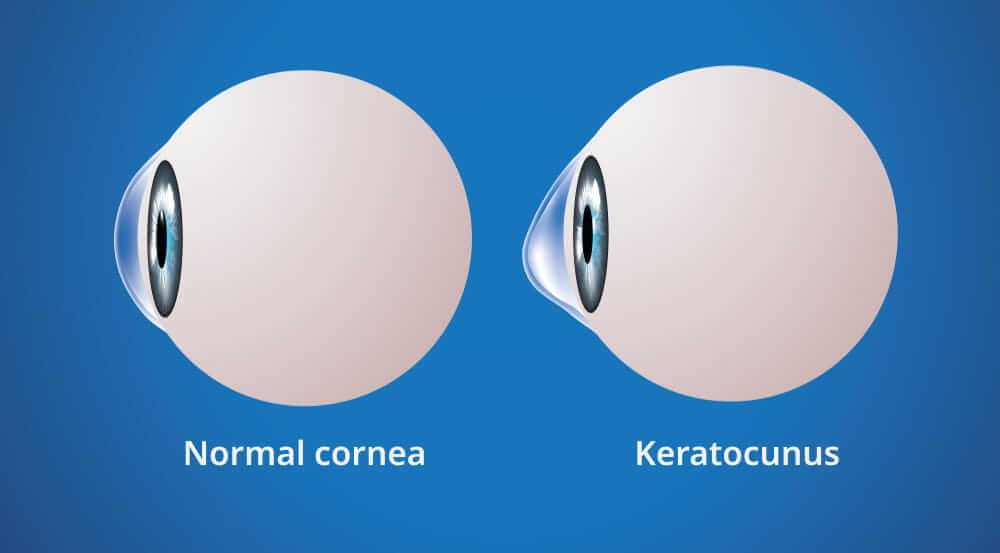C3R For Keratoconus

C3R For Keratoconus
Start the treatment of Keratoconus by C3-R method with UV-X. We have treated HUNDREDS of patients suffering from dreaded corneal disease Keratoconus at CSLC and results are amazing..
It either stabilizes the progression of Keratoconus or it is completely cured. The success rate ranges between 92-95% at.
WHAT IS KERATOCONUS?
Keratoconus is a condition of the cornea in which the normal curvature of the cornea becomes misshapen. In Fact the shape of the cornea becomes conical.
Normal corneal structure is formed of collagen fibres. When you have Keratoconus, the usual chemical links between the collagen strands, which assure the regular shape of the cornea, are defective. This will make your cornea elastic.
When the cross linking between the layers are weak, your cornea will tend to thin, bulge and be deformed. The weakening will likewise distort the images you see and it will change your vision. If left untreated, the fibers will continue to weaken and break down, thereby further damaging your corneal surface and worsening your vision.
An advanced condition may warrant a corneal transplant. This is precisely the condition the Holcomb C3-R procedure wants to avoid.
WHAT ARE THE EARLY SYMPTOMS OF KERATOCONUS?
Early symptoms of Keratoconus are change in the spectacle power. When the disease progresses, vision deteriorates and may not improve with spectacles.
It also causes distortion in vision with multiple images, streaking and sensitivity to light.
Redness, watering and pain in the eye may also take place.
WHAT IS THE TREATMENT FOR KERATOCONUS?
The methods include.
C3-R( CORNEAL COLLAGEN CROSS LINKING WITH RIBOFLAVIN)
We have treated hundreds of patients having keratoconus by CXL method, its results are amazing. It stabilises the shape of cornea. During the treatment cornea is strengthened by treating it with injection Riboflavin and Ultra violet light which creates cross linking of corneal collagen fibres and increases its strength up to 300 %. When detected early enough CXL can arrest the progression of Keratoconus. Patient can retain good sight with glasses, contact lenses and can be even treated by PRK as well as INTACS implantation.
METHOD
Treating keratoconus using C3-R is fast and safe. The procedure is done on an outpatient basis, with the entire process taking about an hour and a half.
The following are the steps that are followed in administering this treatment option:
- Riboflavin eye drops are absorbed into the cornea.
- The outside of the eye is soaked in a specific wavelength of light.
- This wavelength of light will combine with the riboflavin so that chemical bonds will be created within the cornea.
- The resulting chemical bond will make the cornea more rigid and more stable.
- Expect a bit of discomfort, as some minor irritation may be felt in the next 24 hours.
- The eye doctor will provide you with a protective soft contact lens. You will need to wear this for around a couple of days.
- Eye drop medications will also be prescribed. Apply the eye drops four times a day for the next five days. The frequency will then be lowered to twice a day for the next four weeks.
- The effects of this treatment have been found to be permanent, so this option is a good alternative for those with this condition.
- C3R treatment only arrests the progression of Keratoconus.
- it doesn’t regress the damage of the cornea which has already taken place, before the treatment
- It does not reduce the refractive error.
CORNEAL TRANSPLANTATION
This is a surgical treatment, which is reserved for advanced cases of Keratoconus, where the vision cannot be improved with glasses or contact lenses. Here the central portion of the cornea is removed and replaced with a donor cornea of similar size. Since there is high possibility of complications and graft rejection, the surgery is reserved for most advanced cases.
USES OF CONTACT LENSES
Previously hard contact lenses were used for Keratoconus.
Early Keratoconus can be managed by giving rigid contact lenses to the patient which correct the irregularity of the cornea and provide better quality of vision. However, the disadvantage of contact lenses is that, in severe cases, optimal fitting is not achieved and rigid lenses are more difficult to wear.